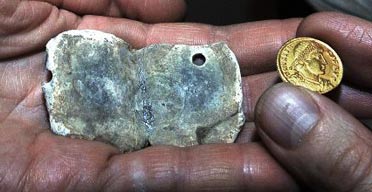Archive for December, 2007
By: The Scribe on December, 2007

It was somewhere around 1,650 years ago that someone living in the Roman Empire became more than a little ticked off with how things were going – and so they committed a small act that could probably be called ‘treason.’ Or blasphemy, for that matter… not to mention that they were criminally defacing state coinage.
The ruler of the Roman Empire at this time was the Emperor Valens, and Roman Britain was experiencing a period of extreme turmoil and unrest – and it didn’t help that an exiled Roman aristocrat named Valentinus was trouncing around the British countryside and stirring up trouble in the form of negative attitudes toward the Roman leadership.
And while curse charms are nothing unusual – Greek and Roman curse objects and tablets are fairly common finds, usually consisting of a curse scrawled on a piece of lead and then thrown into hot springs, or with a hole punched into the lead to hang it up somewhere – a curse object against an Emperor is more than unusual… it’s absolutely unheard of.
Absolutely no curse objects or tablets against an Emperor have been found from Roman times until now, as such an act would have been extremely dangerous. The item which changes all that, is a piece of scrap metal that was found in a Lincolnshire field: whoever cursed the Emperor hammered a coin with an image of the Emperor’s face into a piece of lead, and then folded the lead overtop his face. The piece of lead would have then been taken into a temple and hung up, where the curse could be enacted through the power of the gods.
Since Roman Emperors were often treated as god-like figures – in fact, many were deified after their death – anyone who was discovered cursing an Emperor would have likely suffered extreme torture and death, and their families would have faced possible exile or imprisonment.
Want to read more?


Tomorrow: More Ancient Standard

By: The Scribe on December, 2007

It was around 26,000 years ago that the people living in ancient Southwest France decided that they had a favorite food – very favorite, for that matter. Prior to this discovery, the people had occasionally treated themselves to a hearty dinner of reindeer meat… but they began to ask themselves, why only occasionally? And with a large supply of reindeer to be found in the area – not to mention how tasty they were – why not eat them on a more regular basis?
In fact, so many ancient reindeer bones were found in this area of Europe that the people even began to use the bones to do things like carve calendars into them, use the bones as counting devices, and fashion them into ornamental pieces.
Two recent studies on the consumption of reindeer in ancient times analyzed bone remains from rock shelters and limestone caves, in order to learn things like: how the meat was butchered, information about the reindeer population, and how far the hunters had to travel in order to find the reindeer. The remains showed that around 64,000 years ago, the humans living in these caves had to travel a significant distance to hunt reindeer, and would then only bring back the best cuts of meat to their community.
Over time, the population of reindeer increased at a significant rate – which meant the hunters didn’t have to go far at all to find a good source of nutritious meat. Eventually, 90% of the human populations’ meat came from reindeer, and nearly all parts of the animal were being eaten – and the remaining parts used to create other items.
Talk about a reason for getting coal in your stocking…
Want to read more?


Tomorrow: More Ancient Standard!

By: The Scribe on December, 2007

On the banks of the Nile near Amarna, something a little strange and unexpected turned up… although historians have long believed that Egyptians imported their glass during the reign of Akhenaten, an industrial complex and the remains there now show quite the opposite.
The site at Amarna contained a glass-making shop, with a potter’s workshop and specific rooms that were designated as production areas for blue pigment and architectural inlay materials. An ancient furnace next to the site was utilized by researchers to make their own reconstructed version, which they used to make a full-sized glass ingot out of local sand!
The previously held belief was that the Egyptians imported their glass from surrounding countries and integrated it into their own artifacts, in order to create their elaborate art projects which made ancient Egypt such a famous culture in history – but the discovery of a glass workshop such as this suggests that the Egyptians had far more advanced industrial manufacturing capabilities than they were previously given credit for.
At that rate, who knows how many items they were able to make on their own, without relying on outside trade sources? This would have allowed more money and trade goods to flow inside of Egypt, keeping the wealth inside the country and thus contributing to the richness of their ancient culture.
The glass site near Amarna was found close enough to an ancient temple site that it is likely the workshop was used to produce decorative pieces for the temple during its construction. It is entirely possible that materials for other state buildings came from this location as well, but either way, the Egyptians were far more than simply skilled artists – they were highly efficient and advanced producers of industrial materials as well!
Want to read more?


Tomorrow: Anti-Government sentiment in ancient Rome

By: The Scribe on December, 2007
We apologize for the lack of posts recently, I lost my best quill and had to search the markets for a replacement. Thank you for your patience – The Scribe

So… it turns out that the Classicists were wrong. Or at least, their sources were wrong. The belief that ancient Spartans ‘purged’ their population of weakness was a bit of an exaggeration, to say the least – apparently Spartans didn’t throw their babies off cliffs after all.
Archaeological digs in the area of ancient Sparta turned up plenty of human remains from a spot called ‘the pit’ – also called an ‘apothetes’ – that belonged to teenagers and adults ranging between the ages of 18 and 35, which would have been the prime fighting age range for men in ancient times.
The bones at the bottom of the pit were distinctly lacking in one feature – the inclusion of bones from newborn babies. It seems that even though the ancient Spartans didn’t throw their sickly or deformed babies off of cliffs, other ancient Greek writers made the decision to start the myth in order to demonstrate the intensity of Sparta’s military focus.
Instead, the bones in the pit came from approximately 46 different men who lived during the 6th and 5th centuries BC – confirming a different rumor that Spartans tended to throw criminals, prisoners, or traitors into the pit. It is known that during a war between Sparta and Messene – a city-state near Sparta – the Spartans defeated Messene’s hero Aristomenes and 50 of his warriors, and threw all of them into the pit.

As brutal as the Spartans may have been to their enemies, the discovery sets the record straight about how they treated the more sickly members of their own society – likely just as well as anyone else, probably setting them in service positions if they were too weak to serve in the military. Although for a Spartan that would have been shameful enough, but at least they were allowed to live. The unfounded rumor about baby-chucking was first begun by the historian Plutarch in the 1st century AD.
Want to read more?


Tomorrow: More Ancient Standard!

Next page









